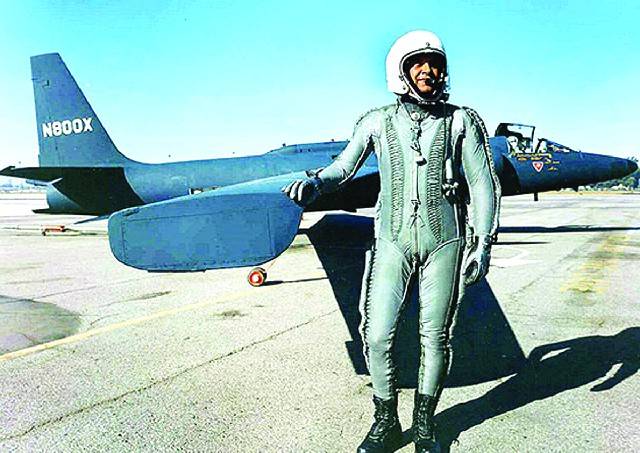
This photograph shows American pilot Francis Gary Powers with the High-Altitude Lockheed U-2 reconnaissance aircraft.
His was the main protagonist in the 1960 U-2 incident which occurred on May 1, when his spy plane was shot down by the Soviet Air Defence Forces while performing photographic aerial reconnaissance deep inside Soviet territory. The single-seat aircraft, flown by CIA pilot Francis Gary Powers, was hit by an S-75 Dvina (SA-2 Guideline) surface-to-air missile and crashed near Sverdlovsk (present-day Yekaterinburg). Powers ejected and parachuted to the ground safely, where he was subsequently captured by Soviet forces.
Initially, U.S. authorities acknowledged the incident as the loss of a civilian weather research aircraft operated by NASA, but were forced to admit the mission’s true purpose a few days later, when the Soviet government presented the captured pilot and parts of the U-2’s surveillance equipment, including photographs of Soviet military bases taken during the mission.
The incident occurred during the presidency of Dwight D. Eisenhower and the premiership of Nikita Khrushchev, around two weeks before the scheduled opening of an East–West summit in Paris. Krushchev and Eisenhower had met face-to-face at Camp David in Maryland in September 1959, and the seeming thaw in U.S.-Soviet relations that resulted had been hailed as the Spirit of Camp David and led people around the world to hope for a peaceful resolution to the ongoing Cold War. The U2 Incident caused great international embarrassment to the United States, led to a dissipation of the amiable spirit of Camp David that had prevailed for eight months, and prompted the dissolution of the planned Paris Summit.
Powers was convicted of espionage and sentenced to three years of imprisonment plus seven years of hard labour, but was released two years later on 10 February 1962 during a prisoner exchange for Soviet intelligence officer Rudolf Abel.

His was the main protagonist in the 1960 U-2 incident which occurred on May 1, when his spy plane was shot down by the Soviet Air Defence Forces while performing photographic aerial reconnaissance deep inside Soviet territory. The single-seat aircraft, flown by CIA pilot Francis Gary Powers, was hit by an S-75 Dvina (SA-2 Guideline) surface-to-air missile and crashed near Sverdlovsk (present-day Yekaterinburg). Powers ejected and parachuted to the ground safely, where he was subsequently captured by Soviet forces.
Initially, U.S. authorities acknowledged the incident as the loss of a civilian weather research aircraft operated by NASA, but were forced to admit the mission’s true purpose a few days later, when the Soviet government presented the captured pilot and parts of the U-2’s surveillance equipment, including photographs of Soviet military bases taken during the mission.
The incident occurred during the presidency of Dwight D. Eisenhower and the premiership of Nikita Khrushchev, around two weeks before the scheduled opening of an East–West summit in Paris. Krushchev and Eisenhower had met face-to-face at Camp David in Maryland in September 1959, and the seeming thaw in U.S.-Soviet relations that resulted had been hailed as the Spirit of Camp David and led people around the world to hope for a peaceful resolution to the ongoing Cold War. The U2 Incident caused great international embarrassment to the United States, led to a dissipation of the amiable spirit of Camp David that had prevailed for eight months, and prompted the dissolution of the planned Paris Summit.
Powers was convicted of espionage and sentenced to three years of imprisonment plus seven years of hard labour, but was released two years later on 10 February 1962 during a prisoner exchange for Soviet intelligence officer Rudolf Abel.


